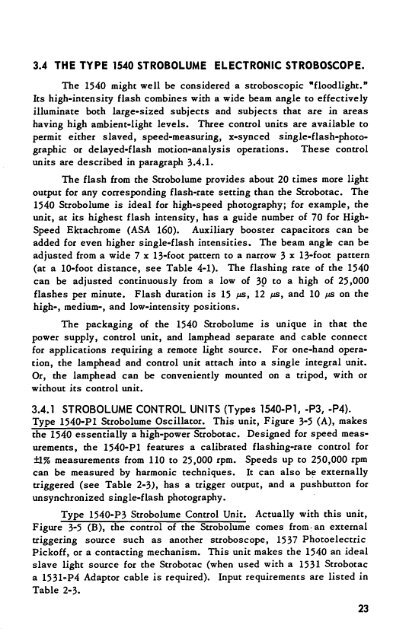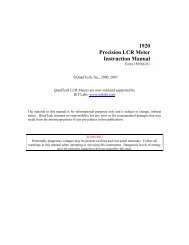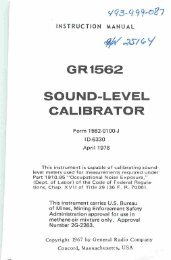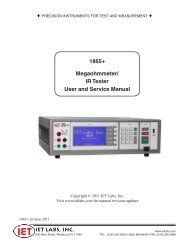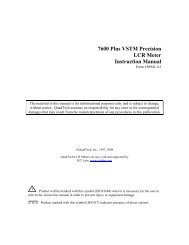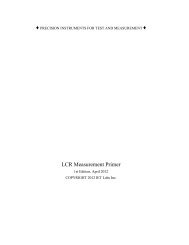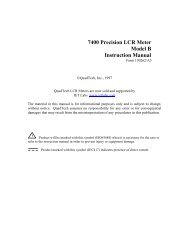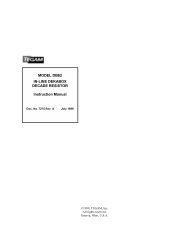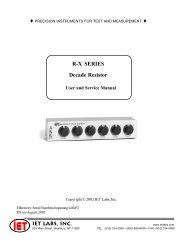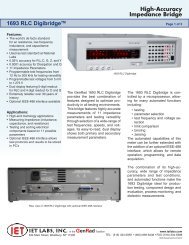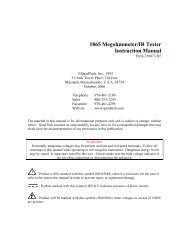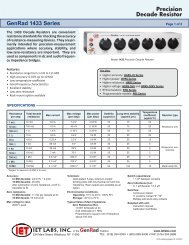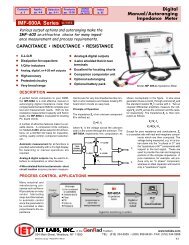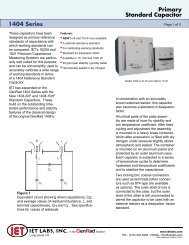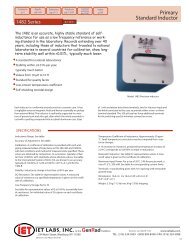Handbook of High Speed Photography - IET Labs, Inc.
Handbook of High Speed Photography - IET Labs, Inc.
Handbook of High Speed Photography - IET Labs, Inc.
Create successful ePaper yourself
Turn your PDF publications into a flip-book with our unique Google optimized e-Paper software.
3.4 THE TYPE 1540 STROBOLUME ELECTRONIC STROBOSCOPE.<br />
The 1540 might well be considered a stroboscopic "floodlight."<br />
Its high-intensity flash combines with a wide beam angle to effectively<br />
illuminate both large-sized subjects and subjects that are in areas<br />
having high ambient-light levels. Three control units are available to<br />
permit either slaved, speed-measuring, x-synced single-flash-photo<br />
graphic or delayed-flash motion-analysis operations. These control<br />
units are described in paragraph 3.4.1.<br />
The flash from the Strobolume provides about 20 times more light<br />
output for any corresponding flash-rate setting than the Strobotac. The<br />
1540 Strobolume is ideal for high-speed photography; for example, the<br />
unit, at its highest flash intensity, has a guide number <strong>of</strong> 70 for <strong>High</strong>-<br />
<strong>Speed</strong> Ektachrome (ASA 160). Auxiliary booster capacitors can be<br />
added for even higher single-flash intensities. The beam angle can be<br />
adjusted from a wide 7 x 13-foot pattern to a narrow 3 x 13-foot pattern<br />
(at a 10-foot distance, see Table 4-1). The flashing rate <strong>of</strong> the 1540<br />
can be adjusted continuously from a low <strong>of</strong> 30 to a high <strong>of</strong> 25,000<br />
flashes per minute. Flash duration is 15 a*s, 12 jus, and 10 fjs on the<br />
high-, medium-, and low-intensity positions.<br />
The packaging <strong>of</strong> the 1540 Strobolume is unique in that the<br />
power supply, control unit, and lamphead separate and cable connect<br />
for applications requiring a remote light source. For one-hand opera<br />
tion, the lamphead and control unit attach into a single integral unit.<br />
Or, the lamphead can be conveniently mounted on a tripod, with or<br />
without its control unit.<br />
3.4.1 STROBOLUME CONTROL UNITS (Types 1540-P1, -P3, -P4).<br />
Type 1540-P1 Strobolume Oscillator. This unit, Figure 3-5 (A), makes<br />
the 1540 essentially a high-power Strobotac. Designed for speed meas<br />
urements, the 1540-P1 features a calibrated flashing-rate control for<br />
±1% measurements from 110 to 25,000 rpm. <strong>Speed</strong>s up to 250,000 rpm<br />
can be measured by harmonic techniques. It can also be externally<br />
triggered (see Table 2-3), has a trigger output, and a pushbutton for<br />
unsynchronized single-flash photography.<br />
Type 1540-P3 Strobolume Control Unit. Actually with this unit,<br />
Figure 3-5 (B), the control <strong>of</strong> the Strobolume comes from an external<br />
triggering source such as another stroboscope, 1537 Photoelectric<br />
Pick<strong>of</strong>f, or a contacting mechanism. This unit makes the 1540 an ideal<br />
slave light source for the Strobotac (when used with a 1531 Strobotac<br />
a 1531-P4 Adaptor cable is required). Input requirements are listed in<br />
Table 2-3.<br />
23


